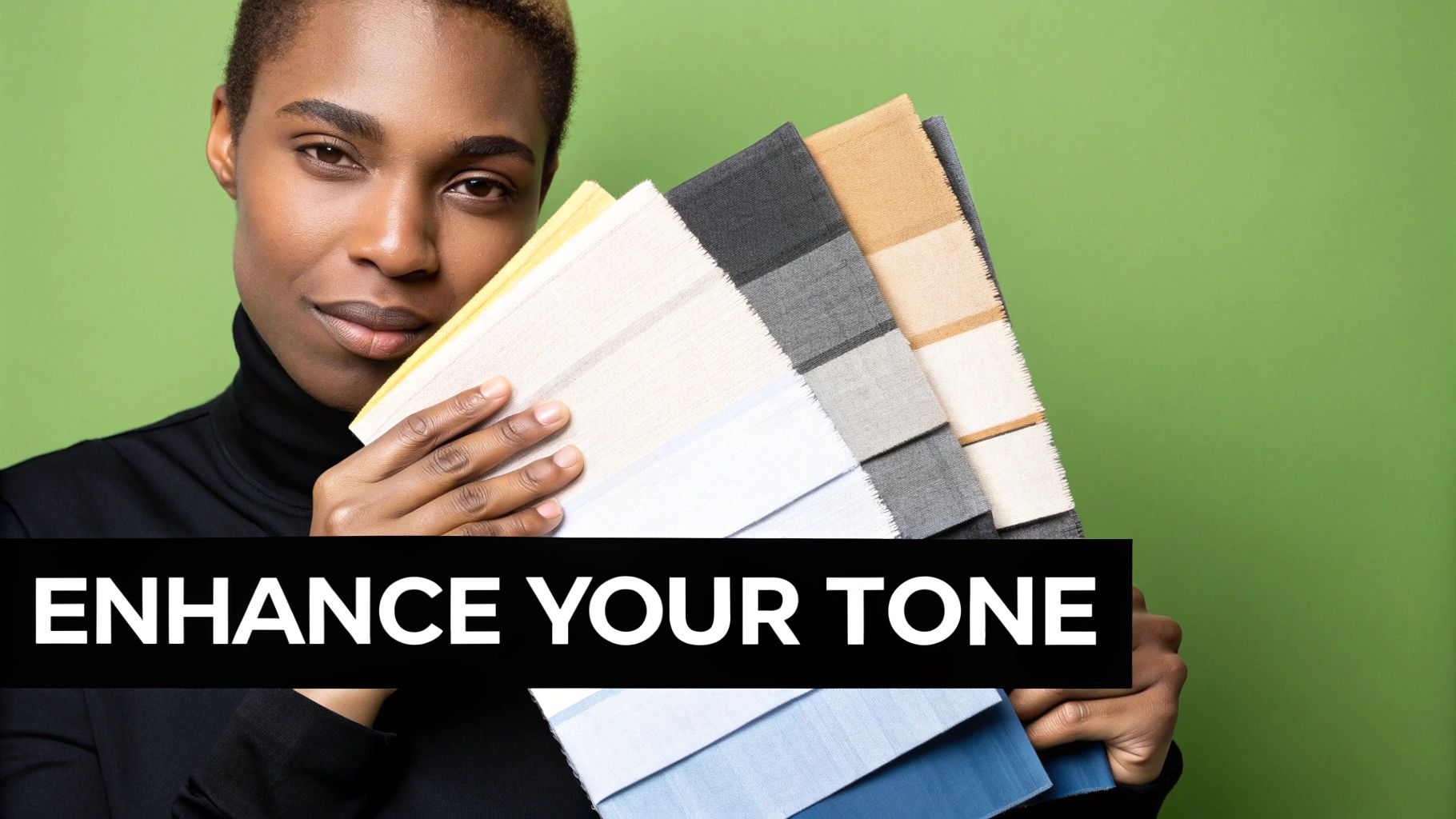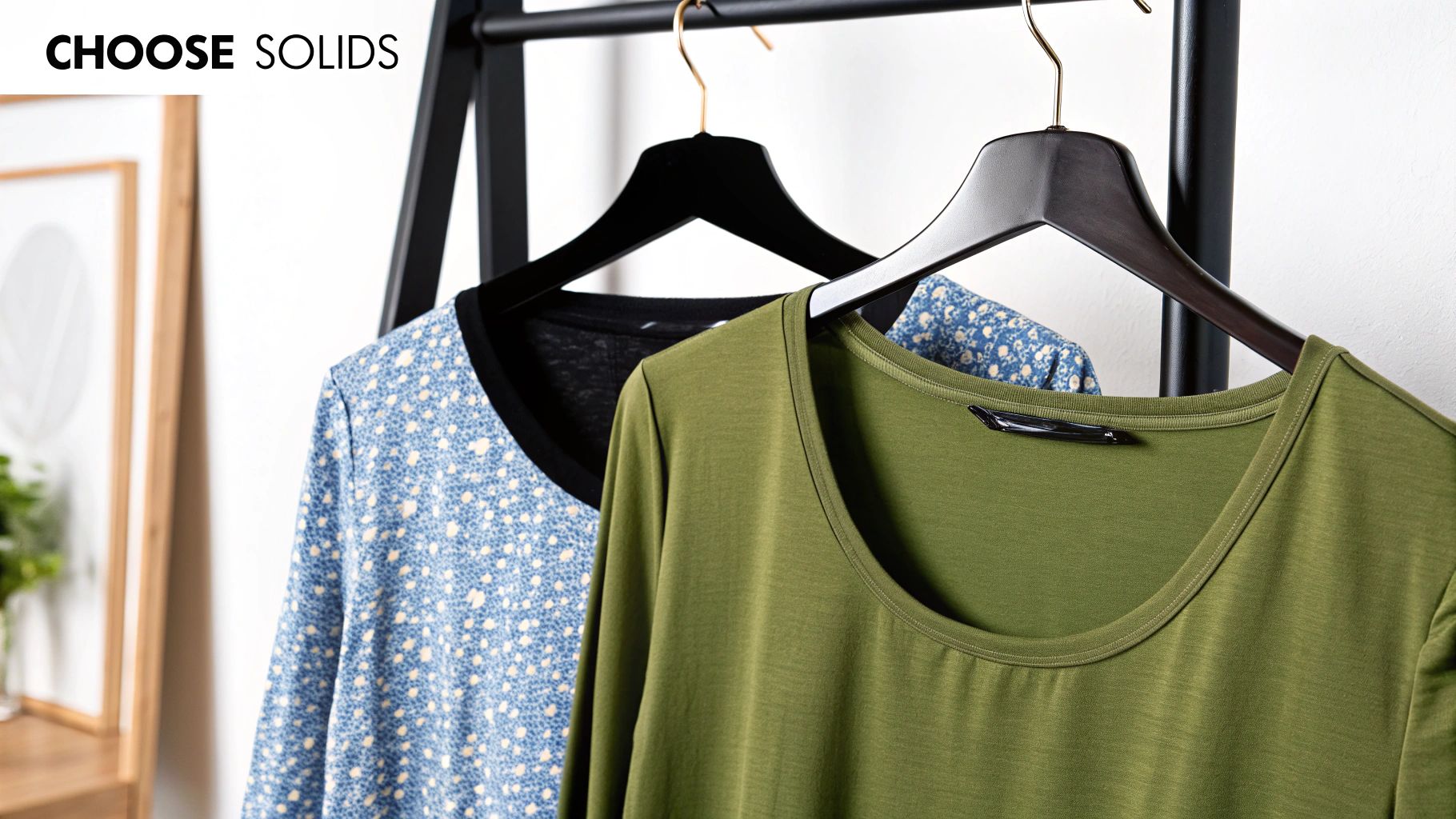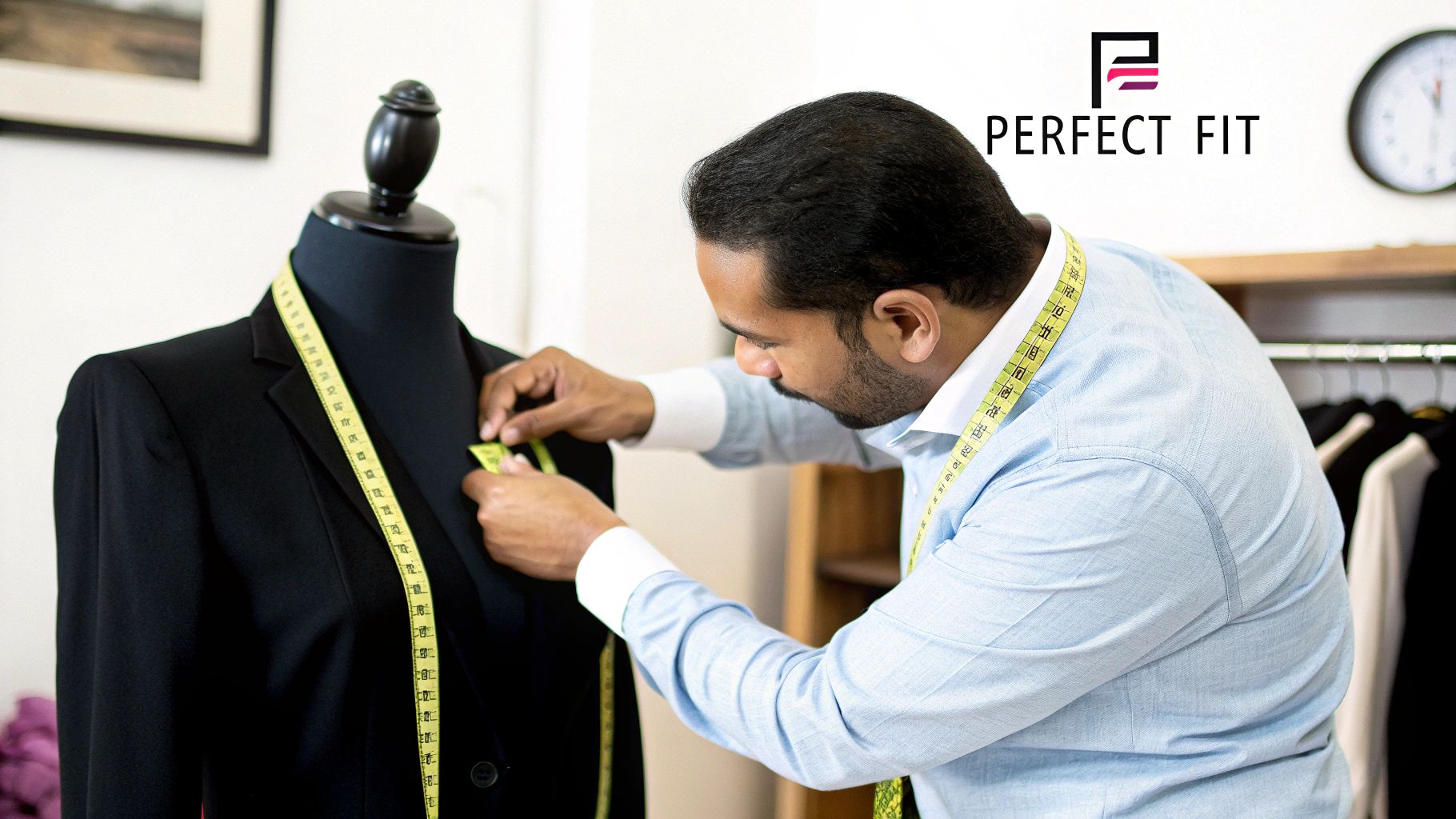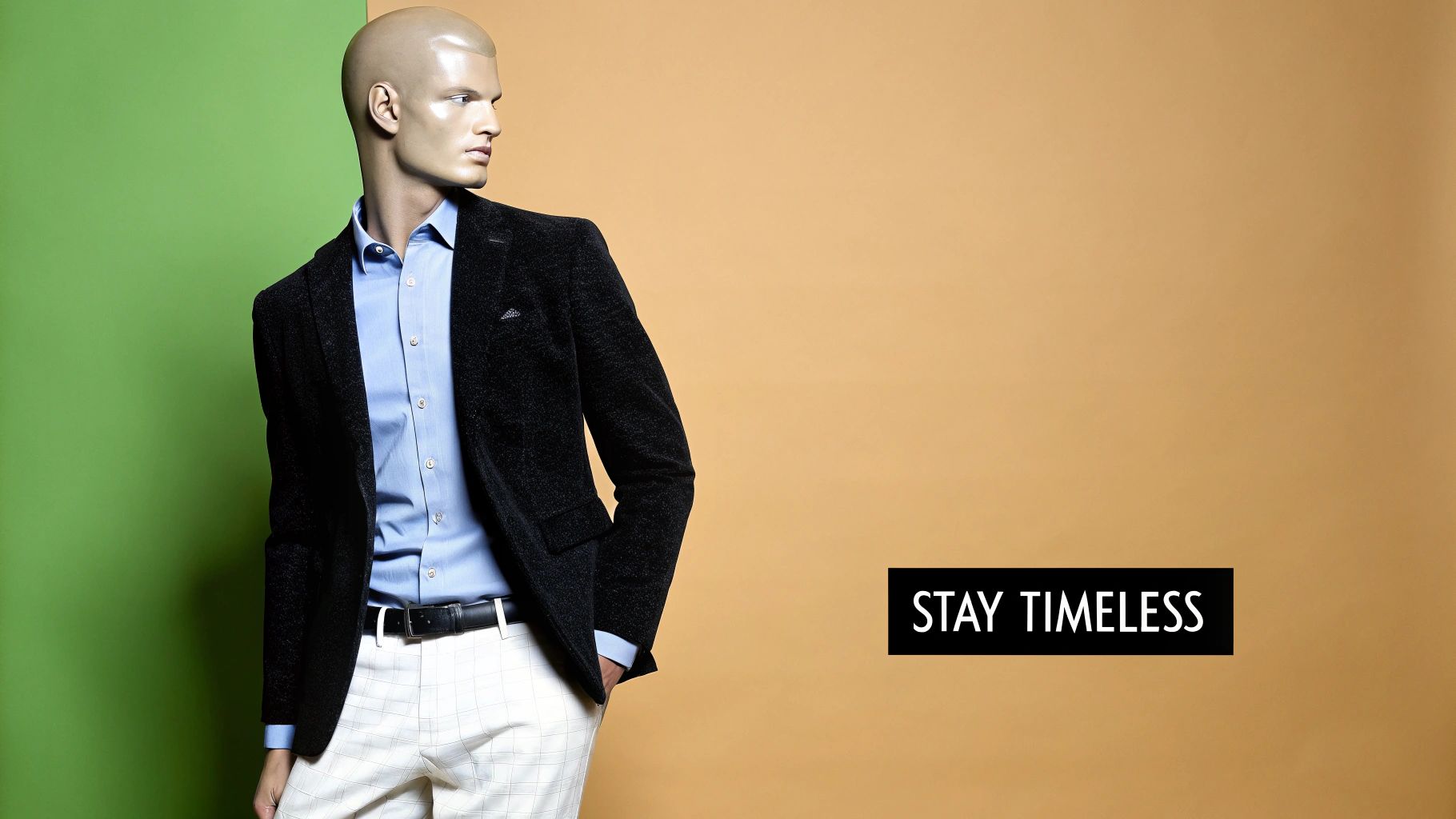What to Wear for Headshots: Top Tips & Outfit Ideas
By Stephen on June 11, 2025
Preparing for Your Close-Up: Headshot Outfit Strategies
A strong headshot is crucial for making a positive first impression. What you wear can significantly impact how you're perceived, so choosing the right outfit is key. This listicle provides specific, actionable advice on what to wear for headshots, helping you project professionalism and confidence. Whether you're updating your LinkedIn profile, building your brand, or refreshing your company's staff photos, these tips will ensure your headshots are polished and represent you authentically. We'll cover key aspects, from selecting flattering colors to understanding industry dress codes, so you can confidently prepare for your close-up. If you have additional questions about headshots in general, you can find answers to some headshot frequently asked questions.
This listicle will guide you through the following essential style strategies:
- Color Coordination: Discover how to choose colors that enhance your natural features.
- Pattern Power: Learn why solid colors often work best and when patterns might be appropriate.
- Fit & Tailoring: Understand the importance of proper fit and tailoring for a polished look.
- Trends & Timelessness: Navigate the line between modern style and avoiding overly trendy choices that quickly become dated.
- Industry Standards: Consider professional norms in your field when selecting attire.
- Necklines & Collars: Learn how necklines and collars can enhance or detract from your overall appearance in a headshot.
1. Choose Colors That Complement Your Eyes and Skin Tone
For truly effective headshots, colour isn't just an aesthetic choice; it's a strategic one. The right hues can enhance your natural features, making your eyes sparkle and creating a harmonious, polished look. Think of your headshot as a mini-branding exercise: you want colours that complement, not compete with, your complexion and eye colour, drawing attention to your face and conveying professionalism. This is especially important for conveying a positive first impression, whether it's on LinkedIn or a company website. What to wear for headshots can significantly impact how you are perceived.

Understanding Your Colour Palette
Consider your natural colouring as your starting point. Are you warm, cool, or neutral toned? Warm tones tend to have golden or olive undertones in their skin and often have brown, amber, or hazel eyes. Cool tones often have pink or blue undertones and typically have blue, grey, or green eyes. Neutral tones can be a blend, allowing them to wear a wider range of colours effectively.
When preparing for your headshot, exploring different outfit ideas for pictures can help you feel more confident. The "8 Outfit Ideas for Pictures: Slay Your Next Photoshoot" from wearz provides excellent starting points for inspiration.
Colour Recommendations for Different Eye Colours
Blue Eyes: Navy, soft blue tones, and contrasting warm colours like coral or peach can make blue eyes pop. Avoid overly bright blues that can wash you out.
Green Eyes: Rich jewel tones like emerald green, forest green, or even burgundy can enhance green eyes. Consider warmer tones like olive or brown for a softer look.
Brown Eyes: Brown eyes are incredibly versatile. Warm earth tones such as rust, burnt orange, or deep purple create a striking contrast. Deep blues and greens also work beautifully.
Hazel Eyes: Hazel eyes, with their unique blend of colours, can be enhanced with jewel tones like amethyst or sapphire. These colours bring out the flecks of gold and green within the iris.
Tips for Choosing the Right Colours
Test in Natural Light: Before your headshot session, try on your chosen outfits in natural light. This provides the most accurate representation of how the colours will appear in photographs.
Multiple Options: Bring a selection of clothing options to your shoot. This gives you and your photographer the flexibility to experiment and see what works best on camera.
Consult Your Photographer: Discuss your colour choices with your photographer. They understand how lighting affects colour and can provide valuable insights. They can also advise on how certain colours will translate on camera and complement their studio's backdrop.
Avoid Clashing Colours: Ensure your clothing choices don't clash with the backdrop or create an overly busy image. Solid colours are generally preferred for headshots, minimizing distractions and keeping the focus on your face.
Consider the Image You Want to Project: What message do you want to convey with your headshot? Darker colours can project authority and professionalism, while lighter colours can convey approachability and warmth. Think about your industry and the impression you want to make.
By carefully considering your colour choices, you can ensure your headshots are not just pictures but powerful tools that showcase your best self. Your outfit can be a crucial element in achieving a professional and impactful image, especially when considering what to wear for headshots.
2. Opt for Solid Colors Over Busy Patterns
For professional headshots, solid colours reign supreme. They offer a clean, uncluttered backdrop that keeps the focus squarely where it should be: on your face. Patterns, however eye-catching they might be in person, can become distracting and even visually jarring in a photograph. This is especially true for small, intricate patterns or bold stripes, which can create a moiré effect or appear distorted on camera. When deciding what to wear for headshots, remember that simplicity is key for a professional and polished image. A busy pattern can detract from your expression and overall presentation, potentially undermining the image you want to project.

Understanding the Power of Solid Colors
Solid colours create a sense of visual harmony in headshots. They provide a consistent, even tone that complements your features without competing for attention. This allows viewers to connect with your expression and perceive you more clearly. Consider examples like corporate executives in solid navy blazers, projecting authority, or actors in jewel-toned tops, highlighting their expressiveness. Even creative professionals can benefit from solid colours, choosing hues that reflect their personality while maintaining a polished look. Learn more about Opt for Solid Colors Over Busy Patterns and find additional examples.
Choosing the Right Solid Colors
Complement Your Skin Tone: Just as with choosing any outfit, consider your skin's undertones. Warm tones often look best in earthy colours, while cool tones are enhanced by blues and greens.
Avoid Extremes: Steer clear of extremely bright or neon colours. These can be overwhelming and wash out your complexion under studio lighting.
Texture for Interest: While the colour should be solid, the fabric doesn't have to be boring. Consider textures like linen, silk, or even a subtle knit to add visual interest without distracting from your face.
No Logos or Branding: Keep the focus on you, not a brand. Avoid clothing with visible logos or branding, as this can appear unprofessional and date the headshot quickly.
Tips for Implementing Solid Colors
Test Your Options: Try on different solid-coloured outfits under natural light before your photoshoot. See how they interact with your skin tone and hair colour.
Coordinate with the Backdrop: Discuss the studio backdrop with your photographer. Choose a solid colour that complements the backdrop without blending in completely.
Consider Your Industry: What message do you want to convey? Darker colours often project authority, while lighter shades can convey approachability. Align your colour choice with your professional image.
Multiple Shades: Bring several solid-coloured options to your shoot. This provides flexibility and allows for adjustments based on the lighting and overall aesthetic.
By opting for solid colours, you ensure your headshot is a clean, professional representation of you. This timeless approach keeps the focus where it belongs - on your face and expression - making a positive and lasting impression. Choosing the right attire for headshots is an essential step in presenting your best self, particularly when considering what to wear for headshots.
3. Ensure Proper Fit and Tailoring
For truly impactful headshots, the fit of your clothing is just as crucial as the colour. Well-fitted clothing creates clean lines, enhances your silhouette, and conveys a polished, professional image. Conversely, ill-fitting garments can create unflattering distractions, drawing attention away from your face and undermining the overall quality of your headshot. What to wear for headshots extends beyond mere aesthetics; it's about presenting a confident and put-together version of yourself. This detail is particularly important for creating a strong first impression, whether for your LinkedIn profile, company website, or marketing materials.

Understanding the Importance of Fit
Consider your clothing as the frame for your portrait. A well-tailored frame enhances the artwork, while a poorly fitted one detracts from it. Baggy clothing can make you appear larger than you are, while overly tight clothing can create awkward wrinkles and bulges. The goal is to achieve a streamlined and flattering silhouette that complements your features. Learn more about ensuring proper fit and tailoring to perfect your headshot attire.
Examples of Proper Fit
Business Professionals: A tailored blazer, fitted at the shoulders and waist, projects confidence and professionalism. Avoid overly boxy or oversized jackets.
Actors: A crisp button-down shirt, fitted without gaping at the buttons, creates a classic and polished look. Ensure the sleeves are the correct length.
Medical Professionals: A lab coat tailored to your frame enhances your credibility and professionalism. Avoid ill-fitting coats that appear borrowed or unprofessional.
Creative Professionals: A fitted sweater can project a stylish yet approachable image. Ensure the fit complements your body type and avoids looking too casual or sloppy.
Tips for Achieving the Perfect Fit
Professional Tailoring: If your budget allows, invest in professional tailoring. A tailor can adjust your existing wardrobe to ensure a perfect fit for your headshots.
Shoulder Fit: Pay special attention to the fit of the shoulders, as this is the most difficult area to alter. The seam should sit naturally at the edge of your shoulder.
Sleeve Length: Ensure your sleeves are the correct length. They should fall just below your wrist bone when your arms are relaxed at your sides.
Test Your Garments: Before your photoshoot, try on your chosen outfits and move around in them. Sit, stand, and move your arms to ensure the clothing drapes well and doesn't wrinkle or pull in unflattering ways.
On-Set Adjustments: Bring safety pins to your photoshoot for quick adjustments. These can be used to take in loose fabric or fix minor fit issues on the spot.
By prioritizing proper fit and tailoring, you can ensure your headshots project a polished and professional image. Your clothing will enhance your presence, allowing your personality and professionalism to shine through. This attention to detail is a key element in answering the question of what to wear for headshots that truly make an impact.
4. Avoid Overly Trendy or Flashy Clothing
For headshots that stand the test of time, opt for classic attire over fleeting trends. Your headshot is an investment in your professional image, and you want it to remain relevant for years to come. Trendy pieces, flashy jewellery, or statement accessories can quickly date your photos. They may also distract from your face and professional image, shifting the focus to fashion rather than your capabilities. What to wear for headshots should enhance your presence, not overshadow it.

Understanding Timeless Style
Timeless style prioritizes quality fabrics, clean lines, and simple silhouettes. These pieces transcend fleeting trends, ensuring your headshot remains professional and polished regardless of when it was taken. Think of garments you'd wear to an important business meeting or client presentation - those are generally safe bets for headshots.
Examples of Classic Clothing Choices
- Business Professionals: A classic white button-down shirt is a versatile option, projecting competence and professionalism.
- Corporate Settings: Simple blazers in navy, charcoal, or black add a polished touch without being distracting.
- Casual Environments: Understated sweaters in solid colours convey approachability while maintaining a professional look.
Accessorizing for Timelessness
- Minimal Jewellery: Keep jewellery minimal and classic. Small stud earrings or a simple necklace are appropriate. Avoid large, dangling earrings or statement pieces that can draw attention away from your face.
- No Logos or Graphics: Avoid large logos, graphics, or text on clothing. These elements can date your headshot and appear unprofessional.
Tips for Choosing Timeless Attire
- Consider Your Industry: Dress code expectations vary across industries. Ensure your clothing choices align with the norms of your profession. A creative industry might allow for more flexibility than a traditional corporate environment.
- Err on the Side of Conservative: When in doubt, choose more conservative options. It's always better to be slightly overdressed than underdressed in a professional headshot.
- Focus on Fit: Ensure your clothing fits well and is comfortable. Ill-fitting clothes can be distracting and unflattering in photographs.
- Think Long-Term: Visualize how your headshot will appear in five or ten years. If you question whether an item might look dated in the future, it's best to avoid it.
By choosing timeless pieces and avoiding overly trendy or flashy clothing, you ensure your headshot remains a valuable asset for years to come. This approach presents you as polished, professional, and focused, allowing your skills and experience to take centre stage. This is especially important when considering what to wear for headshots, as they often serve as a first impression in the professional world.
5. Consider Your Professional Industry Standards
For truly effective headshots, understanding industry standards isn't just about fitting in; it's about communicating your professionalism and credibility. Different industries have varying expectations for attire, and your headshots should reflect these nuances. What might be suitable for a creative director could be entirely inappropriate for a solicitor, highlighting the importance of tailoring your look to your specific profession. Your headshot serves as a visual introduction, so aligning it with industry norms conveys your understanding of the professional landscape and reinforces your personal brand. What to wear for headshots can significantly impact how you're perceived within your field.
Understanding Industry Expectations
Researching industry standards is crucial for a successful headshot. Are you in a field that values traditionalism, or is it more progressive and open to individual expression? Conservative sectors like finance or law typically favour formal attire, while creative industries might embrace more contemporary styles. Understanding these subtle differences is key to creating a headshot that resonates with your target audience and projects the right image.
Learn more about how industry standards can impact your professional photo.
Examples of Industry-Specific Attire
Finance: Classic suits in navy or grey, paired with crisp white shirts and understated ties, project competence and trustworthiness.
Creative Industries: Stylish yet professional attire, such as a well-tailored blazer with a unique blouse or a contemporary dress, allows for more personality while maintaining a polished image.
Healthcare: Depending on your role, a white coat, scrubs, or professional business attire can be appropriate. Consider what best represents your interaction with patients or colleagues.
Technology: Smart casual attire, such as a collared shirt or blouse with well-fitting trousers or a skirt, often strikes the right balance between professionalism and innovation.
Legal: Traditional business formal wear, such as a dark suit and tie or a conservative dress, is generally preferred, reflecting the seriousness and formality of the legal profession.
Tips for Aligning with Industry Norms
Research Your Field: Explore what successful professionals in your industry typically wear for their headshots. Company websites and LinkedIn profiles offer valuable insights.
Consider Your Role: The level of formality expected in your role will influence your clothing choices. Senior executives might opt for more formal attire than entry-level employees.
Dress for Where You Want to Be: If you're transitioning industries, dress for the role you aspire to, projecting ambition and foresight.
Seek Advice: Ask colleagues, mentors, or career advisors for guidance on appropriate attire for your industry and position.
Reflect Your Personal Brand: While adhering to industry standards, ensure your outfit reflects your personal brand and allows your personality to shine through.
By considering your professional industry standards when choosing your headshot attire, you ensure your image aligns with your career goals and resonates with your target audience. Your headshot becomes more than just a photograph; it becomes a strategic tool for communicating your professionalism and expertise in your chosen field.
6. Pay Attention to Necklines and Collar Styles
The neckline and collar area is crucial in headshots as it frames your face and significantly impacts the overall composition. The right neckline can enhance your facial features, create flattering lines, and contribute to a professional appearance. Conversely, the wrong choice can be distracting or unflattering, detracting from the positive impression you want to make. What to wear for headshots extends beyond just colours and includes these crucial details.
Understanding Neckline Impact
Necklines create visual cues that draw the viewer's eye. They can create an illusion of length, breadth, or softness, influencing how your face and upper body are perceived. A well-chosen neckline complements your face shape and overall outfit, contributing to a polished and professional image. When considering industry standards for your headshot attire, you may find inspiration from examples of fashion product photos from ProdShot.
Neckline Recommendations for Different Face Shapes
Oval Faces: Oval faces are versatile and can wear most necklines. V-necks, scoop necks, and boat necks all tend to be flattering.
Round Faces: V-necks and other elongating necklines create a sense of length and slim the face. Avoid high necklines that can make the face appear wider.
Square Faces: Softer necklines like scoop necks or rounded V-necks help balance the angles of a square face. Avoid sharp, angular necklines.
Heart-Shaped Faces: Wider necklines like scoop necks or boat necks can balance a narrower chin. Avoid high necklines that emphasize the forehead.
Long Faces: Higher necklines like crew necks or turtlenecks can help shorten the appearance of a long face. Avoid deep V-necks that further elongate the face.
Tips for Choosing the Right Neckline
Consider Your Outfit: The neckline should complement the overall style of your outfit. A classic button-down shirt conveys professionalism, while a soft scoop neck can create a more approachable look.
Test in Different Poses: Try on your chosen outfits and practice different poses you might use during your headshot session. This helps you see how the neckline looks from various angles.
Ensure a Comfortable Fit: The neckline shouldn't be too tight or too loose. A comfortable fit allows for natural movement and prevents the fabric from bunching or pulling.
Pay Attention to Collar Details: If wearing a collared shirt, ensure the collar lies flat and isn't wrinkled or creased. The collar should frame your face neatly and contribute to a polished appearance.
Bring Options: As with colour choices, bring several different neckline options to your headshot session. This allows you and your photographer to experiment and find what looks best on camera and under the studio lighting. This flexibility is key for ensuring your headshots reflect your best self.
By carefully considering neckline and collar styles, you can enhance your facial features, create a flattering silhouette, and project the professional image you desire. This attention to detail elevates your headshots from simple pictures to powerful tools that convey confidence and competence.
6-Point Headshot Clothing Comparison
| Aspect | Choose Colors That Complement Your Eyes and Skin Tone | Opt for Solid Colors Over Busy Patterns | Ensure Proper Fit and Tailoring | Avoid Overly Trendy or Flashy Clothing | Consider Your Professional Industry Standards | Pay Attention to Necklines and Collar Styles |
|---|---|---|---|---|---|---|
| Implementation Complexity 🔄 | Medium – requires understanding personal color palettes | Low – simple choice of solid colors | High – requires tailoring and fitting | Low – select classic, timeless pieces | Medium – research industry standards | Medium – select flattering necklines for face shape |
| Resource Requirements ⚡ | Moderate – needs color knowledge and wardrobe options | Low – choose solid color garments | High – requires budget and time for alterations | Low – minimal wardrobe investment | Moderate – requires research and possible wardrobe updates | Moderate – variety of garments to test |
| Expected Outcomes 📊 | Enhances natural features and eye color, polished appearance | Keeps focus on face, timeless and professional look | Polished silhouette, professional and confident appearance | Timeless headshots, professional and versatile | Aligns appearance with industry norms, increases credibility | Flattering framing of face, enhances overall composition |
| Ideal Use Cases 💡 | When aiming to highlight natural traits and create visual harmony | Suitable for most professional headshots focusing on clarity | Essential for executives, actors, professionals needing sharp image | For long-lasting professional photos avoiding fashion trends | Professionals in fields with clear dress codes | Important for anyone wanting to enhance face and compositional focus |
| Key Advantages ⭐ | Maximizes natural beauty, complements skin and eyes | Simple, camera-friendly, consistent results | Perfect fit boosts confidence and appearance | Photos stay current longer, avoids distraction | Shows industry awareness, appeals to target audience | Improves facial proportions, clean and professional look |
Perfecting Your Headshot: Final Touches and Considerations
Choosing the right attire for your headshot is more than just picking out a nice outfit. It's about strategically crafting an image that reflects your professionalism, personality, and brand. This article has covered key aspects of what to wear for headshots, from understanding colour palettes that complement your features to navigating industry-specific dress codes. Let's recap some of the most crucial takeaways.
Key Takeaways for a Powerful Headshot
Colour Coordination: Remember that colours communicate. Selecting colours that harmonise with your skin tone and eyes can make a significant difference in how vibrant and engaging you appear.
Solid Foundations: Solid colours provide a clean and professional backdrop, ensuring that your face remains the focal point of the image. Avoid busy patterns that can distract the viewer.
Fit and Tailoring: The fit of your clothing is paramount. Properly tailored attire presents a polished and put-together look, projecting confidence and attention to detail.
Timeless Style: Trends come and go. Opting for classic styles ensures your headshots remain relevant and professional for years to come. Avoid overly flashy or trendy pieces that can quickly date the image.
Industry Standards: Understanding the dress code norms within your profession is vital. Aligning your attire with industry expectations reinforces your credibility and professionalism.
Necklines and Collars: Paying attention to neckline and collar styles can subtly enhance your features and frame your face effectively.
The Impact of a Professional Headshot
Mastering these concepts is invaluable for anyone seeking to elevate their professional image. A strong headshot is often the first impression you make, whether on LinkedIn, a company website, or a marketing brochure. It's a powerful tool for building your personal brand, attracting new opportunities, and making a lasting impact. For job seekers in the UK, particularly in competitive sectors like finance or tech, a compelling headshot can be the differentiating factor that sets you apart. Similarly, for small businesses in Ireland looking to enhance their online presence, professional headshots of team members project credibility and build trust with potential clients.
A well-chosen outfit plays a critical role in creating a headshot that truly represents you at your best. By following the advice outlined in this article, you can ensure your headshot portrays confidence, professionalism, and a strong sense of self. This preparation is an investment in your career and personal brand, paving the way for future success.
Want professional headshots without the wardrobe worries? LinkedInHeadshots.ai allows you to skip the outfit planning altogether! Upload your selfies and let our AI generate stunning, studio-quality headshots in minutes, freeing you to focus on other important aspects of your professional life. Visit LinkedInHeadshots.ai today and experience the future of headshots.